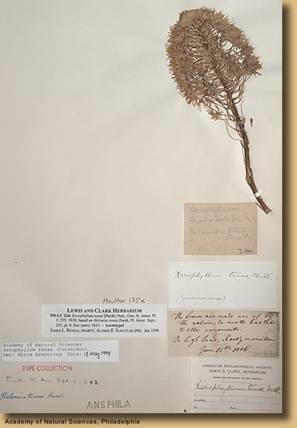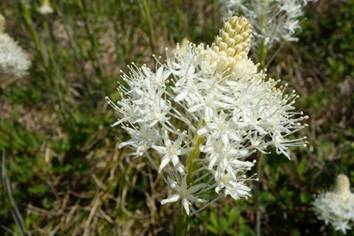here is a great abundance of a species of bear-grass which grows on every part of these mountains. Its growth is luxouriant and continues green all winter but the horses will not eat it. Meriwether Lewis June 15, 1806 – Bitterroot Mountains
Beargrass, to start off – is not a grass but a member of the lily family. It can grow to about 6 feet tall, with olive, grass-like basal leaves. The leaves are scabrous (rough) and have a toothed (serrated) margin and grow up to 35 inches long. The flowers grow on a long stalk with many small, clumped flowers on the upper end of the stalk. Beargrass tends to flower in 5 or 7 year cycles, and then dies, sending off shoots from the rhizomes (underground stem) to form a new clump. Communities of beargrass can go years without producing a single bloom, and then poof! Hundreds can bloom at once. Beargrass clumps grow very slowly and are generally resistant to all but the hottest fires.
Here’s a photo of the sample collected by Lewis and Clark:

I’ve only ever heard the plant referred to as beargrass – but other noted names are soap grass, squaw grass, Indian basket grass, and quip-quip (?). The plant is found in the western North America from British Columbia south to California and east to Wyoming in alpine and subalpine meadows. In California it can be found at lower elevations in the coastal fog belt. It can be a confounding plant for the mountaineer with a heavy pack trying to traverse a steep alpine slope as its upper leaves are quite slippery in one direction (rough in the other) and have led to many a slide and tumble.
The genus Xerophyllum (dry grass) and tenax (meaning to hold fast) gives you an idea of the habitat where the plant is found – dry alpine areas. Most ridges in Oregon and southern Washington have a mantle of pumice that rained down from the countless volcanic eruptions of the region. These and general alpine soils are very well drained and exceptionally dry during the summer. The climate is wet but the moisture flows out of the soil very quickly, setting up drought-like conditions during the summer. Beargrass does exceeding well in this arid climate – like some transplanted dry-land bunchgrass from the steppe east of the Cascades.
Young leaves are supposedly eaten by bears – but this seems more of trying to match the name with a function than visa versa. I did come across several references indicating that grizzly bears were known to use it for denning bed material. More often the culprit of clipped leaves is deer, elk, mountain goats, or the pika. In the Cascades you generally see this plant beginning at about 4,500 feet in elevation or so. For me, it’s the harbinger of the coming alpine zone. So I’m always looking, looking for that first beargrass clump while gaining elevation – providing some incentive to keep on plugging along; indicating that the reward of the open alpine zone is not too far above. These photos are from last weekend’s hike up Mt Deception near Snoqualmie Pass.

Native Americans would regularly venture to the higher elevations to gather beargrass for basket and hat weaving. David Douglas (of Douglas fir fame) the Pacific NW explorer noted “Last night my Indian friend Cockqua arrived here from his tribe on the coast and brought me three of the hats made on the English fashion, which I ordered when there in July; the fourth, which will have some initials wrought in it, is not finished but will be sent by the other ship. I think them a good specimen of the ingenuity of the natives and particularly also being made by a little girl, twelve years old. ….I paid one blanket for them”.
Douglas’ overly imaginative biographer, William Norwood, later read between the lines and somehow interpreted this journal entry to argue that Douglas, with his praise for a “little girl’s” ingenuity, was repressing and disguising his romantic entwinement with a nubile “Chinook Princess”.
Beargrass is pretty enchanting – but this claim as an influence may be a stretch
